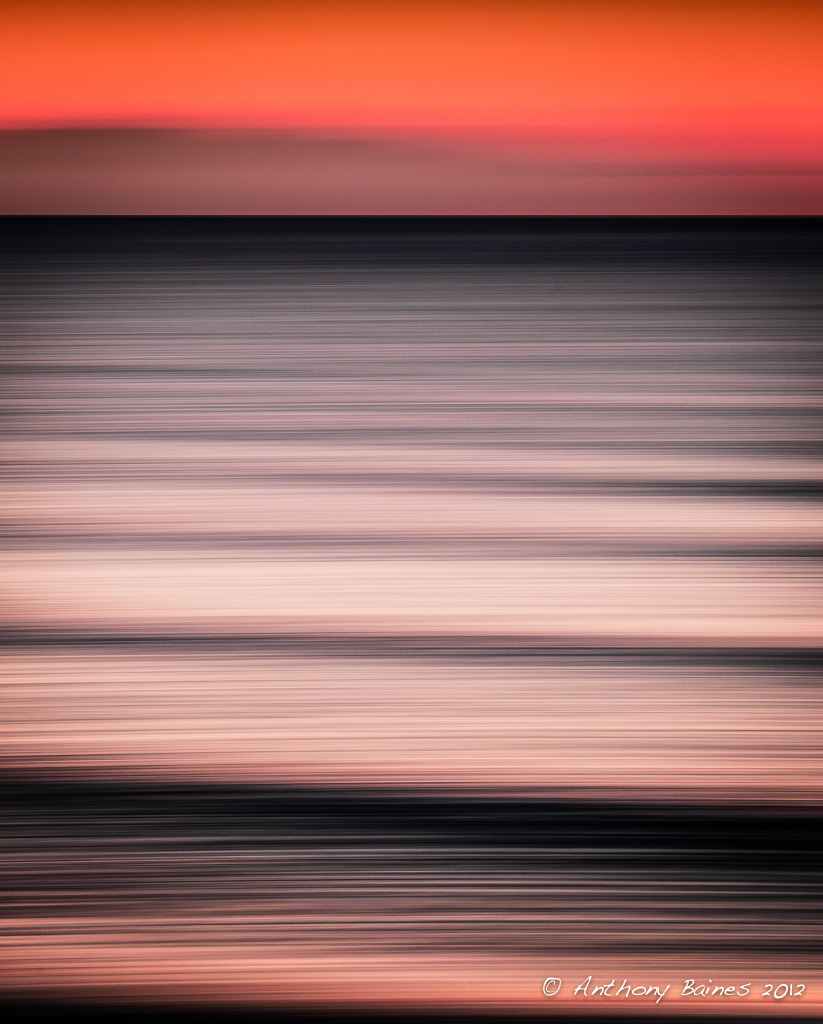 |
| Dawn over the English Channel, in abstract |
One of the things that I enjoy is to try to simplify the subject to the point where its essence can be abstracted. It's possible to create an impression of the subject that almost discards the original and yet leaves the intrinsic rhythms intact.
One approach is to pan the camera with a slow shutter speed across a static subject. This removes details, and yet, done correctly, leaves behind the rhythmic elements that can define the subject's intrinsic nature.
Many years ago, in film days, I used occasionally to try panning the camera on static subjects to get this impressionistic view. It never really worked for me. I now realise that the constraints that we all felt with the expense of film (especially colour slides) meant that I never worked at it hard enough.
Yet another of the benefits of digital is the ability to take a lot of pictures and really work at a subject at essentially no cost. Reviewing and refining the method of panning while working on a picture helps enormously, and this can really only be done with digital.
Over the past few years, I have occasionally tried this again; here are a couple from this year that I quite like. Both of these required a reasonable amount of work to generate a selection of images that represented what I was after, and from which I was able to choose one that I like best of all.
Waves approaching a shore have a natural rhythm and periodicity that can be brought out by removing all the general splashing of the sea by panning camera horizontally. Trees whose energy is directed upwards can be an abstracted from the forest using a vertical pan.
It should be possible to do something like this in Photoshop (by applying a motion blur for instance), but I've never felt that approach is terribly satisfactory. By working on the subject with the camera and trying variations of technique, speed, direction is possible to obtain very pleasing abstraction of subjects without any postprocessing.
The way I go about this is to choose a shutter speed that is sufficiently long to allow blurring while I pan the camera fairly rapidly across the subject, keeping the movement as smooth as possible. The nature of the subject will dictate the shutter speed but typically between 1/4 and 1/30 second, using a relatively normal focal length (any focal length suitable to the subject, but usually with a standard zoom). Normally this can be done with setting the camera to its lowest ISO with shutter speed priority. On very bright days it may be necessary to add a neutral density filter, especially if you want to retain some control of depth of field.
Typically I pan the camera over the subject and just take one picture that includes the area of interest. I'll repeat the panning several times, because each attempt yields a different result. Then I review the pictures on the back of the camera and make adjustments to shutter speed, exposure compensation etc. I might end up with 50 tries for a single image.
The one at the top of page comes from Dungeness a few days ago. Phil, Martin and I arrived on the beach before dawn, and this was a picture I had previsualised. The picture was taken almost immediately before sunrise.
The last picture comes from some bluebell woods near us last spring. I have tried the panning technique each year for the last three or four, and generally get something that I rather like. This one is a bit of a favourite.
Many other photographers have tried this, and it's worth looking at their work for inspiration. As an example, Julieanne Kost has done slow exposures from a car window, so that the motion of the vehicle represents panning across the subject. I've tried several times myself with limited success -- but that won't stop me trying again.
 |
| Impressions of a bluebell wood, #3. |
No comments:
Post a Comment